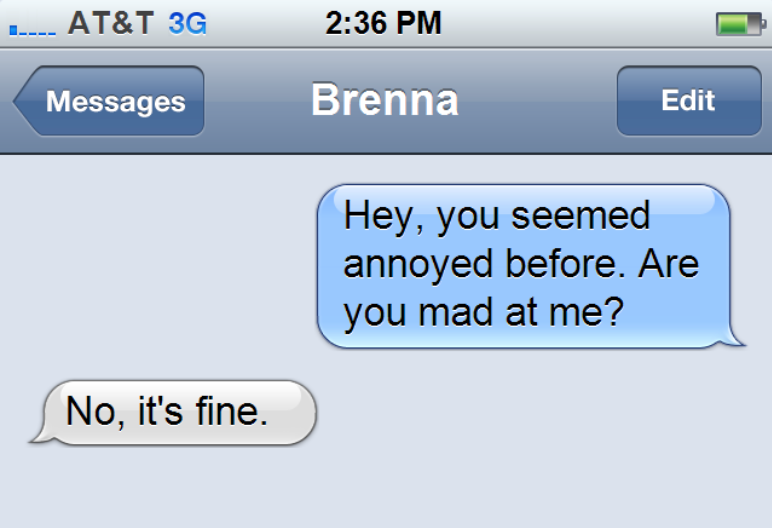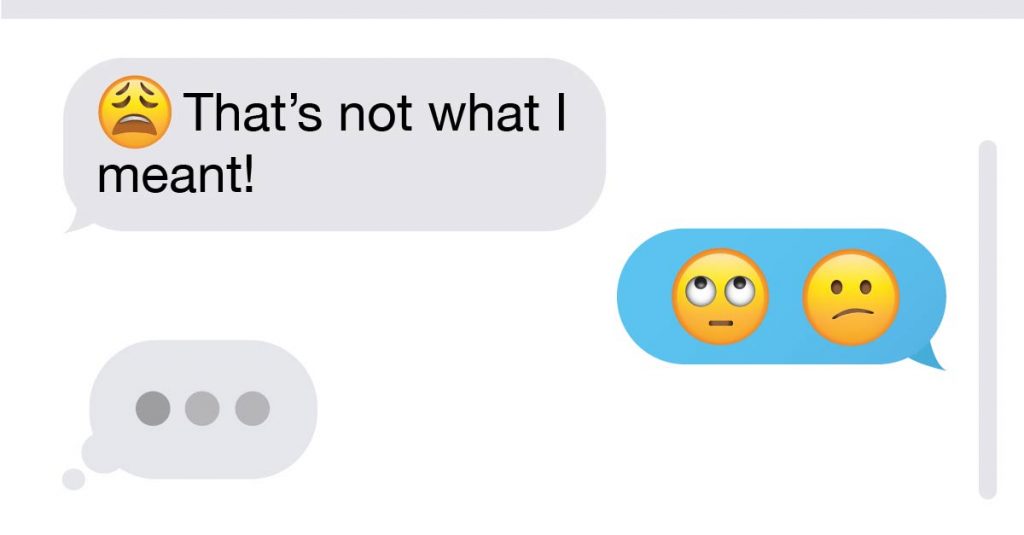This month, a student board I’m on held a communication style presentation session.
Not the usual meeting to plan an event, or to give updates and keep everyone on the same page, but to talk about tone, and what we sound like to ourselves when we’re texting each other.
We were all getting tripped up over messages: someone’s “sure.” sounded angry, a “kk” came across as dismissive, and replying with a single emoji was sometimes considered too aloof. After a few too many misinterpretations, we decided we needed a meeting just to clarify how we talk online.1

It hit me somewhere between “use fewer exclamation points” and “no one is mad, promise” – when did communication become this complicated?
There’s a scene from Modern Family where Phil Dunphy’s old girlfriend texts him, suggesting to catch up. Claire, his wife, insists the message has a tone, and implies that the ex is looking to get back together with him, and to prove her point reads out their texts with an added theatrical voice. Phil then brushes her off and in this situation, incorrectly says, “There’s no tone in texting!”
In case you haven’t watched Modern Family, here is the link to the clip I’m refereeing to: https://youtu.be/73O_pRuoBx0?si=NNqmx8e91kL7umB2

I love how this scene demonstrates how neutral a text message is, as a medium of communication. I like to think that they’re both right. And it is exactly because there is no inherent tone in texting that we project a tone onto it as we read. We can’t help it. The mind fills in the emotional color, even when none is written. That “fine.” sounds nothing like “fine!”; an ellipsis at the wrong moment can feel like the world is ending.
McLuhan argued that every medium doesn’t just deliver content, it changes the nature of the message itself. The form reshapes the meaning. 2
In the book Digital Media and Society, this idea gets a modern update: media aren’t just channels, they’re environments that structure how we interact and what can be said.3
A coffee shop, a classroom, and a Discord server all have their own “acoustics.”4 The way we speak adjusts instinctively to the environment, but digital media blur those environments together until we forget the rules of tone that belong to each.
A text message, then, isn’t just a mini version of speech. It’s a completely different language, one without pitch, pause, or facial expression, where timing and typography carry emotional weight.
The period becomes the new passive-aggressive sigh.
The delay becomes the new cold shoulder.
The typing dots are like our modern equivalent of a held breath.
McLuhan warned that new media “numb human awareness” at first.5 We think we’re just sending words, but the medium quietly rewires how those words are received.
Its like every platform has a personality. Because some topics are appropriate for some digital spaces, and not really for others. Think about it: the same sentence “Hey, can we talk?” will land differently depending on where you send it.
- Email: Feels like a meeting request. You start scanning for attachments.
- WhatsApp: Urgent, possibly emotional. Someone’s feelings are involved.
- Discord: Probably followed by a meme.
- Instagram DM: Dramatic. Possibly romantic?.
- Slack: Corporate dread.
Each platform carries its own micro-culture and tone, its own media logic (since we’re being theoretical about it).6 The platform isn’t neutral, it shapes how we express emotion, how we interpret intention, even how we experience time.
A three-minute delay in a text feels normal. A three-minute delay on Discord feels like ghosting. The same message can be tender or terrifying depending on the app it lives in.
When we say, “I didn’t mean it that way,” what we really mean might be, “I didn’t realize what this platform would do to it.”7

Which brings me back to that communication meeting with my student board. We found ourselves negotiating unspoken digital dialects, deciding when “okay” was okay, when a heart emoji was professional, and when it was too much.
It’s absurd, and yet completely necessary. Because if every platform is a new social environment, then every environment demands its own etiquette.
We live in a state of media entanglement, multiple mediums, each with their own tempo and tone.8 You can go from sending a formal email to your professor to bantering on Discord to leaving your friend on read, all within ten minutes. And each shift requires a micro-translation.
It’s funny, digital communication promised clarity and connection. Instant messaging was supposed to remove friction. Instead, we’ve ended up building workshops to prevent tone wars.
McLuhan might argue that this confusion is the message. The friction is the point. Every new medium changes us before we even realize it, and right now, we’re still learning how to sound human through screens.
- https://www.google.com/url?sa=i&url=https%3A%2F%2Fmedium.com%2F%40myle1798%2Flost-in-translation-key-and-peeles-miscommunication-through-texting-dfb9b3dd641&psig=AOvVaw3vP_8TR_8JjTbfls2pA_S7&ust=1760621474709000&source=images&cd=vfe&opi=89978449&ved=0CBUQjRxqFwoTCIDm1KCoppADFQAAAAAdAAAAABAu ↩︎
- Lindgren, Simon. “Digital media and society.” (2021): pg. 29 – 30 ↩︎
- Lindgren, Simon. “Digital media and society.” (2021): pg. 29 ↩︎
- Lindgren, Simon. “Digital media and society.” (2021): pg. 29 – 30 ↩︎
- Lindgren, Simon. “Digital media and society.” (2021): pg. 15 ↩︎
- Lindgren, Simon. “Digital media and society.” (2021): pg. 31 – 32 ↩︎
- https://www.google.com/url?sa=i&url=https%3A%2F%2Fballbearingsmag.com%2F2017%2F02%2F06%2Flost-in-translation%2F&psig=AOvVaw3vP_8TR_8JjTbfls2pA_S7&ust=1760621474709000&source=images&cd=vfe&opi=89978449&ved=0CBUQjRxqFwoTCIDm1KCoppADFQAAAAAdAAAAABAE ↩︎
- Lindgren, Simon. “Digital media and society.” (2021): pg. 31 ↩︎



I have to admit that the first reason I clicked on your blog was because of your title and the mention of Phill Dunphy. The episode is honestly a great representation of what it is like when texting, I often have to realize who I’m talking to and what they’re like face to face to be able to interpret their message the right way. But I think problems come about really quick anyways, for example: my mom is a really dry texter and either sends a ‘thumbs up’ or an ‘okay’ and I myself often forget to reply and send a message back after multiple hours passed. It is very easy to interpret it the wrong way. Lastly, I think you’re completely right about different platforms conveying different tones, maybe it is better to just ask and talk about (like you did with your meeting) to prevent confusion and problems when it could be avoided this way.
I have to admit that most ‘fights’ or ‘discussions’ with my boyfriend start because one of us misreads the tone of a message, so this is definitely something I have thought, and talked about often with people. However, before this blog I never truly realized that there are indeed differences in how to read messages, or how they are read, across digital platforms. This also reminds me of how emoji’s can be interpreted completely differently, especially across generations. Where Gen Z often uses the skull emoji to show they are ‘dying with laughter’, my grandma might send it after announcing someone has passed away. Maybe in the future those ‘tone etiquettes’ or meetings like the one you had will be standard in the workplace… Anyways, interesting take and definitely something to think about!